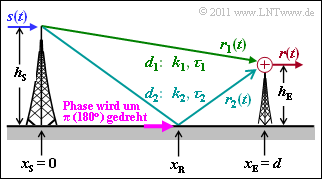Difference between revisions of "Aufgaben:Exercise 2.2Z: Real Two-Path Channel"
| Line 36: | Line 36: | ||
|type="{}"} | |type="{}"} | ||
$\Delta d \ = \ ${ 2,996 3% } $\ \ \rm m$ | $\Delta d \ = \ ${ 2,996 3% } $\ \ \rm m$ | ||
| − | $\ Delta \tau \ = \ ${ 9,987 3% } $\ \ \rm ns$ | + | $\Delta \tau \ = \ ${ 9,987 3% } $\ \ \rm ns$ |
{What equation results for the path delay difference $\delta \tau$ with the approximation $\sqrt{(1 + \varepsilon)} \approx 1 + \varepsilon/2$ valid for small $\varepsilon$ ? | {What equation results for the path delay difference $\delta \tau$ with the approximation $\sqrt{(1 + \varepsilon)} \approx 1 + \varepsilon/2$ valid for small $\varepsilon$ ? | ||
Revision as of 14:10, 15 April 2020
The sketched scenario is considered in which the transmitted signal $s(t)$ reaches the antenna of the receiver via two paths: $$r(t) \hspace{-0.15cm} \ = \ \hspace{-0.15cm} r_1(t) + r_2(t) =k_1 \cdot s( t - \tau_1) + k_2 \cdot s( t - \tau_2) \hspace{0.05cm}.$$
Note the following:
- The delays $\tau_1$ and $\tau_2$ of the main and secondary paths can be calculated from the path lengths $d_1$ and $d_2$ using the speed of light $c = 3 \cdot 10^8 \ \rm m/s$ .
- The amplitude factors $k_1$ and $k_2$ are obtained according to the path loss model with path loss exponent $\gamma = 2$ (free-space attenuation).
- The height of the transmit antenna is $h_{\rm S} = 500 \ \rm m$. The height of the receiving antenna is $h_{\rm E} = 30 \ \rm m$. The antennas are separated by a distance of $d = 10 \ \ \rm km$.
- The reflection on the secondary path causes a phase change of $\pi$, so that the partial signals must be subtracted. This is taken into account by a negative $k_2$ value.
Note:
- This task belongs to the chapter Mehrwegeempfang beim Mobilfunk.
Questionnaire
Sample solution
- Actually, specifying such a length with an accuracy of one millimeter is not very useful and contradicts the mentality of an engineer.
- We have done this anyway to be able to check the accuracy of the approximation searched for in the subtask (4).
(2) If you fold the reflected beam right vpn $x_{\rm R}$ downwards (reflection on the ground), you get again a right-angled triangle. From this follows: $$d_2 = \sqrt{d^2 + (h_{\rm S}+ h_{\rm E})^2} = \sqrt{10^2 + (0.5+ 0.03)^2} \,\,{\rm km} \hspace{0.1cm} \underline {=10014.035\,{\rm m}} \hspace{0.05cm}.$$
(3) With the results from (1) and (2) you get for the lengths– and the runtime difference:
- $$\Delta d = d_2 - d_1 = \hspace{0.1cm} \underline {=2,996\,{\rm m} \hspace{0.05cm},\hspace{1cm} \delta \tau = \frac{\delta d}{c} = \frac{2,996\,{\rm m}}}{3 \cdot 10^8 \,{\rm m/s}} \hspace{0.1cm} \underline {=9,987\,{\rm ns} \hspace{0.05cm}.$$
(4) With $h_{\rm S} + h_{\rm E} \ll d$ the above equation can be expressed as follows: $$d_1 \hspace{-0.1cm} \ = \ \hspace{-0.1cm} d \cdot \sqrt{1 + \frac{(h_{\rm S}- h_{\rm E})^2}{d^2} \approx d \cdot \left [ 1 + \frac{(h_{\rm S}- h_{\rm E})^2}{2d^2} \right ] \hspace{0.05cm},\hspace{1cm} d_2 \hspace{-0.1cm} \ = \ \hspace{-0.1cm} d \cdot \sqrt{1 + \frac{(h_{\rm S}+ h_{\rm E})^2}{d^2} \approx d \cdot \left [ 1 + \frac{(h_{\rm S}+ h_{\rm E})^2}{2d^2} \right ] $$ $$\Rightarrow \hspace{0.3cm} \delta d = d_2 - d_1 \approx \frac {1}{2d} \cdot \left [ (h_{\rm S}+ h_{\rm E})^2 - (h_{\rm S}- h_{\rm E})^2 \right ] = \frac {2 \cdot h_{\rm S}\cdot h_{\rm E}}{d}\hspace{0.3cm} \Rightarrow \hspace{0.3cm} \delta \tau = \frac{\delta d}{c} \approx \frac {2 \cdot h_{\rm S}\cdot h_{\rm E}}{c \cdot d} \hspace{0.05cm}.$$
- So the correct solution is the solution 3. With the given numerical values you get for this:
$$\Delta \tau \approx \frac {2 \cdot 500\,{\rm m}\cdot 30\,{\rm m}}{3 \cdot 10^8 \,{\rm m/s} \cdot 10000\,{\rm m}} = 10^{-8}\,{\rm s} = 10\,{\rm ns} \hspace{0.05cm}.$$
- The relative falsification to the actual value according to the subtask '(3) is only $0.13\%$.
- In solution 1 the unit is already wrong.
- In solution 2, there would be no propagation delay if both antennas were the same height. This is certainly not true.
(5) The path loss exponent $\gamma = 2$ says that the reception power $P_{\rm E}$ decreases quadratically with distance.
- The signal amplitude thus decreases with $1/d$, and with a constant $K$ applies:
- $$k_1 = \frac {K}{d_1} \hspace{0.05cm},\hspace{0.2cm}|k_2| = \frac {K}{d_2} \hspace{0.3cm} \Rightarrow \hspace{0.3cm} \frac {|k_2|}{k_1} = \frac {d_1}{d_2}= \frac {10011,039\,{\rm m}}{10014,035\,{\rm m}} \approx 0.99 \hspace{0.05cm}.$$
- The two path weights thus only differ in amount by about $1\%$.
- However, the coefficients $k_1$ and $k_2$ have different signs ⇒ Correct are the answers 1 and 3.
